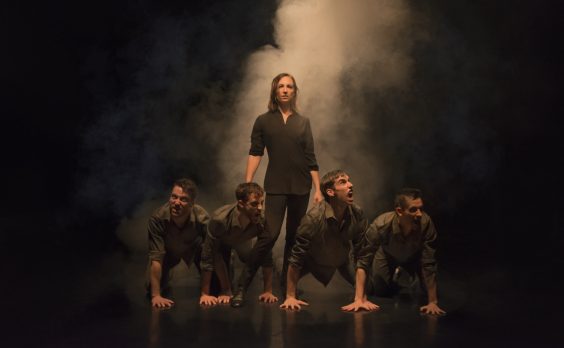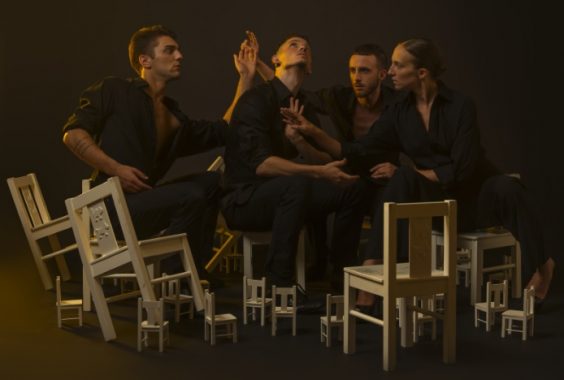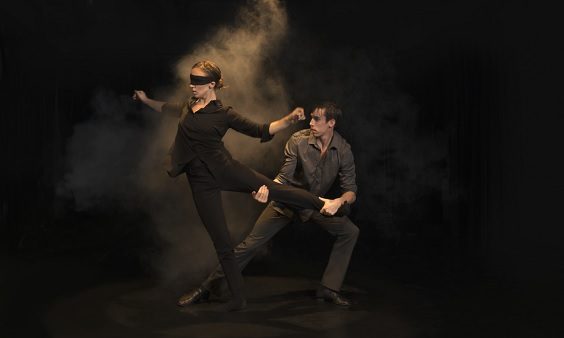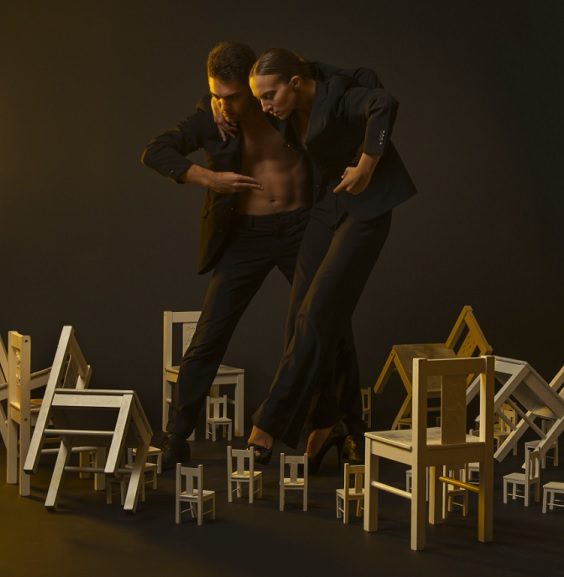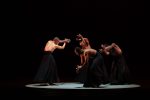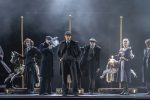9 by Cas Public – Review – Stanley and Audrey Burton Theatre, Leeds
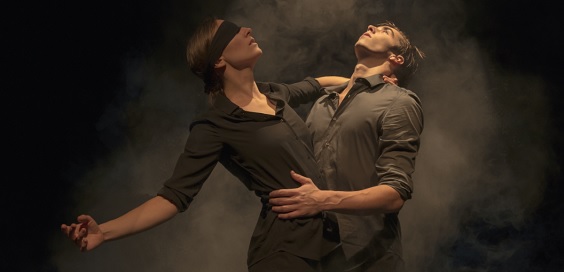
By Eve Luddington, June 2019
Hélène Blackburn founded her Canadian dance company in 1989. Judging by the audience’s appreciation of 9, Cas Public’s first visit to Leeds won’t be its last.
Cai Glover, one of the five dancers, has a hearing impairment: 9 was created ‘as an exploration of the unique way he perceives and experiences music and movement.’ Parts of it are performed to excerpts from Beethoven’s ‘9th Symphony’, the last written by the partially deaf composer.
When the audience enters, three of the dancers are balancing miniature white chairs on their heads, replicas of the ones on which they sit; others of the same sizes are scattered around the stage. Three young audience members are coaxed to join in and then take part in the performance, the youngest on this occasion a girl of seven or eight. They are side-coached and sensitively managed on the whole but importantly, we are aware throughout that these three young people have had no preparation and are trying to work out what’s going on, how to fit in. The strong implication is that they represent deaf people in a hearing world. It’s a high risk strategy by the company – and I have reservations about using audience members in this way – but it’s certainly effective.
“Superb technique”
During the performance, a screen displays headings and video footage which state the difficulties of hearing loss and show the isolation and frustration of a young boy with hearing aids. Were it not for this, the dance would have been engaging but impenetrable to me: there were no other explanatory notes except a flyer of few words. As it was, people like me who seek ‘intellectual’ meaning, still struggled to find it – and that, perhaps, was intended.
The 50-minute dance is brilliantly performed and held my attention completely. It left me feeling that a world reliant on sounds and speech is puzzling and disjointed for those with severe hearing loss.
The deep black-box stage of the Stanley and Audrey Burton Theatre is an excellent setting for dance, and this one in particular. The white chairs and darkly clothed dancers are lit by spotlights only, sometimes cued by the performers with a click of the finger. This technical challenge is met with such perfect timing it seems like magic.
It’s a high energy, finely tuned performance. The dancers have superb technique and quality of movement, and their presence is endearing. Their precision, especially when dancing complex moves in unison, is exceptional.
“Something unique”
They begin with rapid, expansive arm gestures reminiscent of sign language, as distorted snippets of Beethoven’s 9th play repeatedly. The music purifies as they move into ballet. And then, the two dance styles are blended together to create something unique.
In one section, the only female in the company dances a ballet on pointes; the two men with her perform ballet with their feet but defy convention by moving their upper bodies jerkily and waggling or windmilling their arms. The impression is of mixed messages; perhaps this is how the world looks and feels for those with severe hearing loss.
There are moments of pointed humour, when the performers communicate most directly with the audience. Sometimes they all come forward, audience participants too, put fingers to their lips and mutter ‘Shush,’ to us. At one point, all the dancers bar one pretend to be dogs; the isolate meows like a cat.
Music occasionally gives way to complete silence, or to noises from the dancers which resemble the sounds voiced by the young deaf boy on screen. That boy has a remote control and a model car. Then the toy car appears on stage, and it’s fitted with a camera. The images it films are projected on the screen, as if the deaf boy is somehow controlling proceedings. And in a way, of course, he is.
“Vulnerability”
The main message of the piece appears on the screen: ‘It’s pretty much impossible to simulate hearing loss. [If it were possible], then people could understand me.’
That understood, 9 emphasises the complexity of hearing loss further by comparing it with blindness. One of the screen titles states that all we need do to imagine blindness is shut our eyes – and the female dancer dons a blindfold. Supported by two of the men, she performs beautifully, but then she’s taunted in a game of ‘Blind Man’s Bluff’. Her vulnerability is glaringly evident.
The point is made but I’m not convinced it’s necessary or fair to compare the loss of one sense so crudely with another. In this performance, the female dancer went on to remove her blindfold and put it on the youngest audience participant who was subjected to ‘Blind Man’s Bluff’, too. Here, I think, the point became laboured. More than that, the otherwise sensitive company overstepped the mark: the poor girl looked genuinely bewildered and I felt she was being exploited.
“Mesmeric”
Those reservations aside, I was impressed by Cas Public and their bravery. They present their exploration of Cai Glover’s perceptions and experiences without sentimentality or cliché; 9 is a work of complete originality. There’s little variation of dynamic in the choreography but, within their chosen range, the dancers retain our interest by their precision, focus and intensity. The repetitious nature of the work is almost mesmeric at times and has a subtle development. The humorous touches were, for me, welcome breaks in my search for meaning.
After the performance, I re-read Cas Public’s flyer. It states that 9 ‘showcases… ‘how movement can rise above our differences, transforming the body into language.’ Only then did it strike me that, although I didn’t understand the language entirely, it was one shared by all those excellent dancers. Cai Glover, who experiences the world so differently, was ‘just’ one of them – and they were all presenting his perceptions. That, perhaps, is the most eloquent proof of the statement.
images: Damian Siqueiros
